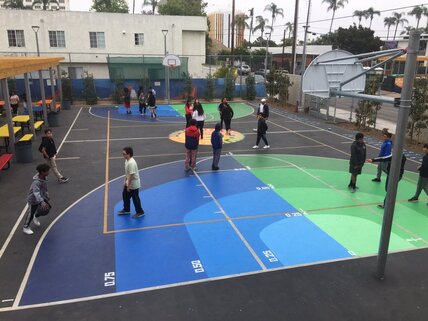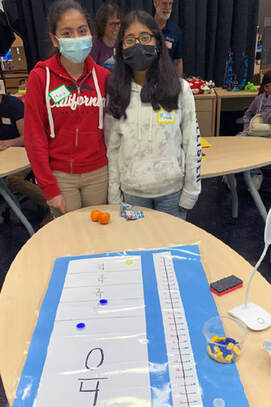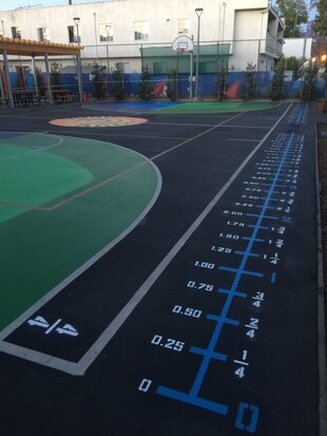UC Irvine School of Education research team scaling Fraction Ball math game in Santa Ana Unified School District
|
A team of researchers from the UC Irvine School of Education, led by Assistant Professor Andres Bustamante, received a two-year, $1.9 million research award from the Advanced Education Research and Development Fund’s (AERDF) EF+Math Program to adapt the innovative math game Fraction Ball for the Santa Ana Unified School District (SAUSD).
In Fraction Ball, lines, arcs and colors are added to the design of a basketball court to emphasize fraction and decimal learning. The traditional 3-point arc is converted to 1 point, and smaller arcs closer to the basket represent shots worth 1/4, 1/2, and 3/4 points on one end of the court and 1/3 and 2/3 points on the opposite end. Fractions are represented on one side of the court and decimals on the other. As a result of the design, children can both visualize the magnitude of fractions and decimals and practice converting between fractions and decimals. A number line on the side of the court helps them keep track of their score. |
“Fractions are a notoriously difficult content area for young students, and they represent a barrier to engage in more complex math like algebra,” Bustamante said. “Many students begin to disengage with math when they struggle with fractions and develop insecure math identities. Fraction Ball is a more accessible way for students to learn fractions; it's playful, hands-on, physically active, and based on the latest research in math learning.”
The Fraction Ball initiative was launched at El Sol Science and Arts Academy of Santa Ana in 2019 where an experimental study showed the game had significant positive impacts on students' fraction and decimal learning. Since 2020, the team has been working with teachers and students in SAUSD to adapt the program to align with the school district’s curricular goals and reflect the strengths and cultural assets of the students and teachers in the district.
The Fraction Ball initiative was launched at El Sol Science and Arts Academy of Santa Ana in 2019 where an experimental study showed the game had significant positive impacts on students' fraction and decimal learning. Since 2020, the team has been working with teachers and students in SAUSD to adapt the program to align with the school district’s curricular goals and reflect the strengths and cultural assets of the students and teachers in the district.
|
In one instance, students from an all-female engineering afterschool club at SAUSD's Lydia Romero-Cruz Academy, called “The FEMINEERS,” designed a table top version of Fraction Ball using low cost materials like bottle caps and a poster board to make a shuffleboard style game. This game is now a central component of the Fraction Ball classroom activities and has been adapted to introduce more advanced concepts like adding unlike denominators (3rds + 6ths or 4ths + 8ths).
“The FEMINEERS show us the power of centering student voices in the design of educational experiences,” Bustamante said. “Fraction Ball was showing strong impacts on the fundamental fraction and decimal skills like adding 3rds and 4ths or converting between fractions and decimals, but we weren’t seeing impacts on the more advanced concepts. By intentionally designing for equity – using very low-cost materials – their game provided us a flexible platform to help students engage with more advanced concepts like improper fractions and unlike denominators. We conducted an experimental study last spring testing their bottle caps game, and for the first time, we saw impacts on those advanced concepts.” Fraction Ball is now a global phenomenon. It has been implemented across three countries – the United States, Kosovo, and Mexico – and has demonstrated strong impacts on students' fraction and decimal learning through six experimental studies. The latest research award from AERDF is to scale Fraction Ball across SAUSD and Lynwood Unified School District in Los Angeles County, and test its impact in a 10,000 student randomized controlled trial. |
|
“It’s been a dream come true to watch Fraction Ball get adopted all over the world,” Bustamante said. “And the more students, teachers, and communities that we partner with the stronger our impacts get. I could never have imagined the ways this project has grown because of the amazing team and partners we have.”
The UC Irvine research team includes School of Education faculty June Ahn, Drew Bailey, Katherine Rhodes, and Lindsey Richland; Research Scientist Kreshnik Begolli, and graduate students Lourdes Acevedo-Farag, Siling Guo, and John Louis-Strakes Lopez. EF+Math is an ambitious initiative to unlock the brilliance inside each student and develop powerful math learners. They fund bold approaches that hold promise to dramatically improve math outcomes for students in grades 3–8. Founded on the belief that students from every background deserve to express their mathematical brilliance, the program explores the possibility that exercising math-relevant executive function skills may mitigate some of the challenges of learning math in under-resourced schools. EF+Math’s five-year program funds multi-disciplinary teams to co-create approaches that integrate executive function skill-building activities into high-quality, evidence-based math instruction. Each team’s work is deeply equity focused, research-informed and designed with educators at the center. Read more about the New Schools Venture EF+Math Program here. |




